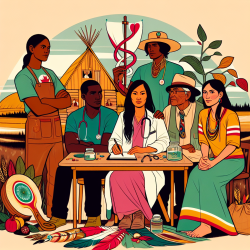Introduction
As practitioners in the field of special education and therapy services, understanding the intricacies of healthcare systems for Indigenous communities is crucial. The research article "Effective health and wellness systems for rural and remote Indigenous communities: a rapid review" by Stefanon et al. offers valuable insights into creating effective health systems that prioritize Indigenous health and wellness. This blog aims to inspire practitioners to enhance their skills by implementing the outcomes of this research or by delving deeper into further studies.
Understanding the Challenges
The Canadian healthcare system has a long history of colonization and assimilation, often marginalizing Indigenous values and approaches to health and wellness. Systemic racism, underfunding, and barriers to access are prevalent issues. Current policies do not always uphold Indigenous Peoples' rights to self-determination, health, and wellness. The rapid review by Stefanon et al. identifies six key themes for effective health systems in rural and remote Indigenous communities:
- Access to primary care
- Multi-directional knowledge exchange
- Culturally appropriate care
- Training and building community capacity
- Integrated care
- Health system funding
Implementing Effective Health Systems
Practitioners can play a pivotal role in addressing these themes to improve healthcare delivery for Indigenous communities. Here are some actionable steps:
- Enhance Access to Primary Care: Work towards reducing geographic and financial barriers to healthcare access. Teletherapy and online services, such as those provided by TinyEYE, can bridge gaps in service delivery.
- Foster Knowledge Exchange: Engage in open communication with Indigenous communities to incorporate their knowledge and practices into healthcare models. This involves respecting and valuing Indigenous ways of knowing and doing.
- Provide Culturally Appropriate Care: Tailor healthcare services to be culturally relevant and inclusive. This means integrating Indigenous medicinal and healing practices into mainstream healthcare systems.
- Build Community Capacity: Invest in training programs that empower Indigenous healthcare providers. Encourage community members to take leadership roles in health and wellness initiatives.
- Promote Integrated Care: Develop partnerships between Indigenous organizations, healthcare providers, and government agencies to create cohesive and comprehensive care systems.
- Secure Sustainable Funding: Advocate for long-term funding solutions that support Indigenous-led health initiatives and infrastructure development.
Encouraging Further Research
While the rapid review provides a foundational understanding, further research is essential to continue improving Indigenous health systems. Practitioners are encouraged to explore additional studies and collaborate with Indigenous communities to tailor solutions that meet their unique needs.
Conclusion
By embracing the outcomes of the research by Stefanon et al., practitioners can contribute to the transformation of health and wellness systems for Indigenous communities. This requires a commitment to cultural sensitivity, open dialogue, and collaboration with Indigenous partners. Together, we can work towards equitable healthcare that honors Indigenous rights and traditions.
To read the original research paper, please follow this link: Effective health and wellness systems for rural and remote Indigenous communities: a rapid review.










